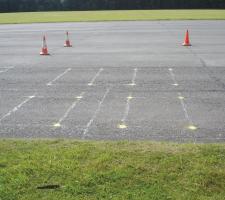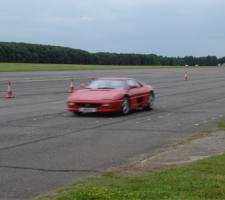
Speed tests were carried out at the Bruntingthorpe Proving Ground located in Leicestershire, England, in July last year
With the Idris system now validated as a speed verification tool, the way is open for loops to be used in more complex enforcement applications
"Idris is ideally suited to being combined with cameras for triggering purposes as it can detect vehicle type and speed with enforceable accuracy," says the company's Managing Director, Bob Lees. "Accreditation actually only gives authenticity to a capability that the system has had for a very long time.
"A combination of customer need and the identification of a niche opportunity drove the validation work. That, and the recognition that in speed verification - and, indeed, any verification application - it's the whole system which counts; it's not just the camera at the front end taking the pictures but the whole supporting infrastructure which needs to undergo validation.
"In many instances Idris is just a part of that whole but it became apparent that for certain markets independent verification was important. Given the near-universal acceptance around the world of the veracity of UK Home Office standards, we set out to confirm Idris's ability to conform to standards set out in the
HOSDB Publication 15/05's tolerance requirement are: a positive error not greater than 2mph (3km/h) or 3 per cent, over 66mph (100km/h); and a negative error not greater than 5mph (8km/h) or 10 per cent, over 50mph (80km/h). The Idris specification is: an accuracy of better than 2km/h (1.25mph) for speeds below 100km/h; and 2 per cent for speeds over 100km/h. Testing confirmed that Idris exceeded both these requirements.
As well as taking into account the quoted accuracies of the Idris system, the validation testing had to consider testing accuracy up to a maximum possible speed; in the end, a top speed of 225km/h(140mph) was achieved. Testing also had to include an independent and sufficiently accurate reference speed measurement system to provide truth data.
Speed tests were carried out at the Bruntingthorpe Proving Ground located in Leicestershire, England, in July 2009. These consisted of 10 runs starting at 32km/h (20mph) and progressing in 16km/h (10mph) intervals up to that top speed of 225km/h. Satellite-based VBox Mini and VBox II units supplied by Racelogic provided the 'ground truth' speed information to which the outputs from Idris were compared.
System comparisons
"The US market was our prime motivator but what the validation testing means is that, worldwide, anyone using Idris as the central mechanism of their speed verification system now has independent assurance of the systems' capabilities," says Lees."Moving forward, the validation work also allows loop-based systems to compete on a different plane.
"If we take the UK as an example, most speed detection equipment there is radar or piezo-based. It's long been the belief that loops can't do what either of these other solutions can. Well, that's not true - they can, and in some cases they can more accurately than anything else.
"Take applications such as measurement at intersections of speed-on-green. Piezos are prone to tearing. All of the acceleration and deceleration, and the attendant surface wear, means they get disturbed and lose their accuracy very quickly. Loops by contrast can actually accommodate quite a lot of movement and stay in calibration far longer.
"It's not very fashionable to say so but well-installed loops can last a long time. Going in-ground might also not be the fashion at present but you have to ask yourself, 'What works just as well?' The answer is not very much. Above-ground detection solutions are very popular but any light-based system is going to suffer in inclement weather conditions.
"Loops aren't the be-all and end-all and their capabilities can be combined with those of other systems. But there are other considerations. In developed countries, Idris Technology Partners' [ITPs'] customers are looking at how to reduce the amount of infrastructure which they have to deploy and maintain. India and other developing countries will probably persist with loops because there is less roadside infrastructure involved. That means less to worry about in terms of security, theft and vandalism. Mexico also faces many of the same issues."
The new market offer
"There are some obvious applications which validation opens the way to. One is straight speed enforcement. Idris works with any installed loop so it would be possible, for instance, to turn any MIDAS site into a speed verification site."Idris's ability to distinguish vehicle types means differential speed limit enforcement using loops is also a possibility. Where, for example, trucks and cars have different posted speed limits, it's possible to have the detection system decide for itself whether a vehicle is breaking the law and trigger cameras as appropriate.
"At intersections, the combination of vehicle classification and speed measurement has safety applications. For example, if the system detects a vehicle travelling at speed and is able to determine by type whether or not it is likely to be able to stop in time, green phases could be extended in order to avert a potential accident. Wrong-way vehicle detection is also a possibility and in tolling applications it can be used to verify pass-through speeds in open-road tolling/electronic toll collection schemes."
A key test result according to Lees is that Idris has been shown to lack a statistical bias.
"Idris doesn't play any favours, in that it's very tight around any given speed. That means, for example, it doesn't overshoot the upper accuracy limit by 5 per cent or undershoot the lower accuracy limit by 3 per cent."
The validated system is already seeing first deployments in the US and ITPs say they are already exploring applications.
Adam Tuton, Executive Vice President and COO of
"The compact design specification focuses use of the product on sites where large infrastructure cannot be supported. The power requirements and communication structure remain the same, with GSM, GPRS, WiFi and Ethernet as standard. Both the SpikeHD and Idris run on embedded Linux operating systems offering standard Linux connectivity and encrypted links," says PIPS Technology's Brian Shockley.
Idris in Australia
Australian"In full system trials in Malaysia, both our red light and speed enforcement systems performed faultlessly. Idris showed its detection strengths and TESS comfortably identified even the smallest of motorcycles travelling in the extremities of their lanes; every type of vehicle was detected. We demonstrated accurate detection of five different classes of vehicle, with varying speed enforcement limits, and all of the TESS/Idris detection classification speeds were verified using GPS."
Trials have also been conducted with the Roads and Traffic Authority of New South Wales on a busy multi-lane roadway, providing an independent, real-world assessment of how the TESS solution would work in both flowing and heavy stop-start traffic conditions. In December 2009, the TESS Digital Capture Unit was gazetted as an approved device for red light and speed enforcement, validating the TESS/Idris combination.
Besides being able to enforce different limits for different vehicle classes, TESS has also demonstrated the system's ability to provide detailed information for traffic analysis applications.
"This represents an integrated approach to traffic enforcement and monitoring solutions and also adds value," Willing continues. "Because we recognise different markets have different standards for deployment, we chose to pursue independent verification, rather than simply relying on a manufacturer's certificate. The TESS unit has achieved certification with the National Measurement Institute, the TESS and Idris combination having proven itself at every level."
Willing says its open architecture allows the TESS Digital Capture Equipment to be applied to any form of automated detection: "Using 22 megapixels, the TESS Digital Capture Unit provides crisp and clear enforcement images, with both colour and infra-red imaging options. We intend to market the system in Australia, Asia and Europe."
TESS is now finalising the integration of the TESS RFID Number Plate (its other core product), the TESS/Idris-based detector and the TESS Digital Capture Unit to cater for more advanced ITS applications.













